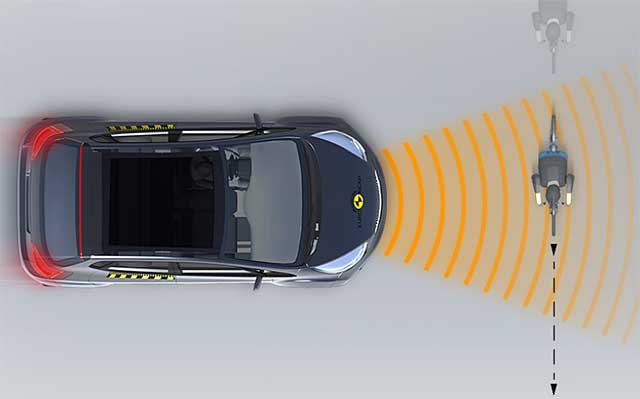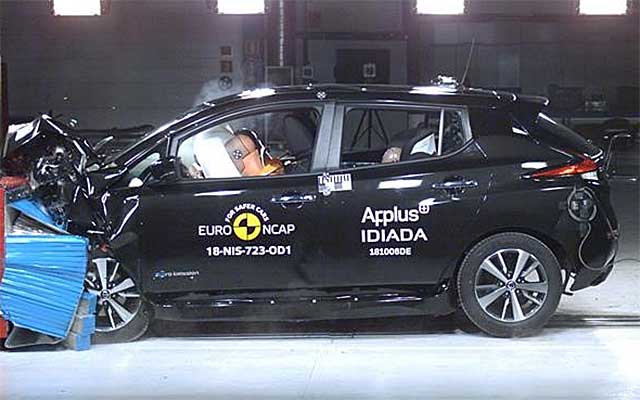25 April 2018
A new assessment has been tested for the first time on the latest Nissan LEAF electric vehicle. It's included with AEB (Automatic Emergency Braking) Pedestrian in a new designation called AEB Vulnerable Road Users (AEBVRU).
Euro NCAP continues to set the agenda with new, more demanding challenges on safety technology to help protect vulnerable road users, including the introduction of the first cycling detection test for AEB.

5-star result
The 5-star result for the new Nissan LEAF published today echoes the success of the original LEAF introduced in 2011 – the first all-electric car rated 5 stars by Euro NCAP. According to the AA this demonstrates that electric vehicles can be among the safest cars on the road.
New power trains must not compromise safety
With consumers turning away from conventional engines, especially diesel, and car manufacturers investing heavily in electric and hybrid vehicles, it's crucial that advancements in safety are not compromised by new power train systems.
The Nissan LEAF comes with many new safety features and demonstrates that environmental friendliness need not come at the expense of improved safety – the safety of those inside the car and those who share road-space with it.
A raft of new tests from 2018
The LEAF is the first car to be assessed against Euro NCAP’s improved and extended protocols for 2018. As road casualty numbers plateau in the UK, more action is needed to ensure that new vehicles offer the latest and best safety technology. For this reason, 2018 sees the introduction of a raft of new tests in Euro NCAP’s assessments, addressing key crash scenarios involving cars, pedestrians and now also the growing number of cyclists.
Detecting cyclists presents new challenges to car manufacturers, both from a hardware and a software perspective: sensors must have a wide angle of view to detect fast-moving cyclists in good time, and complex algorithms are needed to ensure correct identification of potential collision threats while avoiding false activations.
<
Green, clean and safe
Edmund King OBE, AA president, said: “Today’s Euro NCAP results reflect the radical changes we are seeing on our roads with both the growth of electric vehicles (EVs) and cycles in our cities. Drivers should always be responsible and alert for cyclists as our #thinkbike sticker campaign shows but technology can add extra protection. We welcome the new assessments to add further protection for cyclists and pedestrians. The results also show you can have a green, clean and safe car – perhaps the ideal city car?
Drivers should always be responsible and alert for cyclists as our #thinkbike sticker campaign shows but technology can add extra protection
“There is an added potential safety benefit for EVs as the engineers can design them to be more forgiving in the event of collisions with pedestrians, cyclists or motorbike riders as there is no need to accommodate a solid engine block under the bonnet or to resort to a pop-up bonnet to prevent head strikes with stiff engine parts.”
The results also show you can have a green, clean and safe car – perhaps the ideal city car?
Robbert Verweij, Euro NCAP Board member and Senior Policy Advisor at the Dutch Ministry of Transport, said, “It was the drive to save cyclists’ lives which inspired the Dutch government to fund a major project which led to the development of a protocol for detecting cyclists. We are honoured that Euro NCAP has decided to add this protocol to their rating scheme. This first Euro NCAP release of a AEB-Cyclist-equipped vehicle shows what the joint efforts of governments and cyclists’ associations can achieve in collaboration with Euro NCAP.”
Other changes for 2018
Other rating updates for 2018 include:
- Testing of pedestrian detection in darkness and obscure lighting conditions to ensure these systems work at all times.
- Emergency Lane Keeping (ELK) systems are the newest generation of intelligent lane support systems that autonomously take evasive action if the car is in danger of leaving the road or of colliding with another vehicle. New Euro NCAP tests verify that the system reacts to a road edge, marked and unmarked, to ensure the car does not run off-road; that the car returns safely to its lane when an overtaking manoeuvre is attempted and an oncoming vehicle is detected; and that the car is prevented from inadvertently steering into the path of a vehicle which is overtaking in an adjacent lane.
Michiel van Ratingen, Secretary General of Euro NCAP, said “These latest updates in Euro NCAP's active safety testing focus on both the protection of those inside the car and those who share road-space with it.
“Our new assessments demonstrate the increasing level of sophistication that can be achieved by connecting various sensor systems installed on the vehicle. As the cost of these systems drops and computing capabilities increase, standard vehicles will soon become able to help prevent significantly more complex real-life crashes.
As the cost of these systems drops and computing capabilities increase, standard vehicles will soon become able to help prevent significantly more complex real-life crashes
“Euro NCAP seeks to encourage this trend and in the context of a safe systems approach, will continue to challenge auto makers to deliver the highest levels of safety performance as standard, for car occupants and vulnerable road users.”
